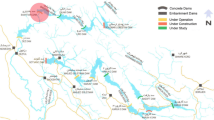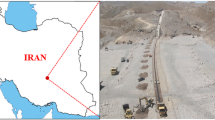Abstract
Blasting is an intrinsic component of mining cycle of operation. However, it is usually associated with negative environmental effects such as blast-induced ground vibration (BIGV) which require accurate prediction and control. Therefore, in this study, Gaussian process regression (GPR) has been proposed for prediction of BIGV in terms of peak particle velocity (PPV), while grey-wolf optimization (GWO) algorithm has been used to optimize the blast-design parameters for the control of BIGV in Obajana limestone quarry, Nigeria. The blast-design parameters such as burden (B), spacing (S), hole depth (Hd), stemming length (T), and number of holes (nh) were obtained from the quarry. The distance from the blasting point to the measuring point (D) and the charge per delay (W) were measured and determined, respectively. The PPV was also measured for the number of blasting operations witnessed. These seven parameters were used as inputs to the proposed GPR model, while the PPV was the targeted output. The performance of the proposed model was evaluated using some statistical indices. The output of the GPR model was compared with ANN model and three empirical models, and the GPR model proved to be more accurate with the coefficient of determination (R2) of approximately 1 and variance accounted for VAF of about 100%, respectively. In addition, the GWO was also developed to select the optimum blasting parameters using the ANN model for the generation of objective function. The output of the GWO revealed that if the number of holes (nh) can be reduced by 45% and W by 8%, the PPV will be reduced by about 94%. Hence, the proposed models are both suitable for prediction of PPV and optimization of blast-design parameters.











Similar content being viewed by others
References
Abati RO, Odukoya AA, Ehimiyen UA, Bankole BO (2002) Limestone and laterite investigation for cement manufacture at Obajana, Kogi state. Geological Survey of a Nigeria, Report. Pp 7.
Abbaszadeh SA, Asheghi R (2018) Optimized developed artificial neural network-based models to predict the blast induced ground vibration. Innov Infrastruct Solut 3:1–10
Akande JM, Lawal AI (2013) Optimization of blasting parameters using regression models in Ratcon and NSCE granite quarries, Ibadan, Oyo State Nigeria. J Scient Res 3:28–37
Akande JM, Aladejare EA, Lawal AI (2014) Evaluation of the environmental impacts of blasting in Okorusu Fluorspar Mine. Namibia Int J Eng Tech 4(1):35–40
Arthur CK, Temeng VA, Ziggah YY (2019) Novel approach to predicting blast-induced ground vibration using Gaussian process regression. Eng Comp. https://doi.org/10.1007/s00366-018-0686-3
Bisoyi SK, Pal BK (2020) Prediction of ground vibration using various regression analysis. J Mining Sci 56(3):378–387
Duvall WI, Petkof B (1959) Spherical propagation of explosion generated strain pulses in rock. USBM Rep Investig 548:21
Ebrahimi E, Monjezi M, Khalesi MR, Armaghani DJ (2015) Prediction and optimization of back-break and rock fragmentation using an artificial neural network and a bee colony algorithm. Bull Eng Geo Environ 75:27–36
Ghasemi E, Ataei M, Hashemolhosseini H (2013) Development of a fuzzy model for predicting ground vibration caused by rock blasting in surface mining. J Vib Control 19:755–770
Gorgulu K, Arpaz E, Demirci A, Kocaslan A, Dilmac MK, Yuksek AG (2013) Investigation of blast-induced ground vibrations in the Tulu boron open pit mine. Bull Eng Geo Environ 72:555–564
Himanshu VK, Roy MP, Mishra AK, Paswan RK, Panda D, Singh PK (2018) Multivariate statistical analysis approach for prediction of blast-induced ground vibration. Arab J Geosci 11:460
ISI (1973) Indian Standards Institute criteria for safety and design of structures subjected to underground blast. ISI Bulletin IS-6922. Indian Standards Institute, New Delhi
Khandelwal M, Singh TN (2006) Prediction of blast induced ground vibrations and frequency in opencast mine. a neural network approach. J Sound Vib 289:711–725
Khandelwal M, Singh TN (2009) Prediction of blast-induced ground vibration using artificial neural network. Int J Rock Mech Min Sci 46:1214–1222
Khandelwal M, Kumar DL, Yellishetty M (2011) Application of soft computing to predict blast-induced ground vibration. Eng Comput 27:117–125
Langefors U, Kilstrom B (1963) The modern technique of rock blasting. Wiley, New York
Lawal AI (2020) An artificial neural network-based mathematical model for the prediction of blast-induced ground vibration in granite quarries in Ibadan, Oyo State Nigeria. Scic African 8:e00413
Lawal AI (2021) A new modification to the Kuz-Ram model using the fragment size predicted by image analysis. Int J Rock Mech Min Sci 138:104595
Lawal AI, Kwon S (2020) Application of artificial intelligence to rock mechanics: an overview. J R Mech Geotech Eng. https://doi.org/10.1016/j.jrmge.2020.05.010
Lawal AI, Onifade M, Abdulsalam J, Aladejare AE, Gbadamosi AR, Said KO (2020) On the performance assessment of ann and spotted hyena optimized ann to predict the spontaneous combustion liability of coal. Comb Sci Techn. https://doi.org/10.1080/00102202.2020.1815196
Lawal AI, Kwon S, Kim GY (2021) Prediction of the blast-induced ground vibration in tunnel blasting using ANN, moth-flame optimized ANN, and gene expression programming. Acta Geophy. https://doi.org/10.1007/s11600-020-00532-y
Mirjalili S, Mirjalili SM, Lewis A (2014) Grey Wolf Optimizer. Adv Eng Soft 69:46–61
Muro C, Escobedo R, Spector L, Coppinger R (2011) Wolf-pack (Canis lupus) hunting strategies emerge from simple rules in computational simulations. Behav Process 88:192–197
Onifade M, Lawal AI, Aladejare AE, Bada S, Idris MA (2019) Prediction of gross calorific value of solid fuels from their proximate analysis using soft computing and regression analysis. Int J Coal Prep Util. https://doi.org/10.1080/19392699.2019.1695605
Patel AK, Gorai AK, Chatterjee S (2016) Development of Machine Vision-based System for Iron Ore Grade Prediction using Gaussian Process Regression (GPR). Pattern Recognit Inf Process, 45–48.
Raina AK, Murthy VMSR, Soni AK (2014) Flyrock in bench blasting: A comprehensive review. Bull Eng Geol Environ 73(4):1199–1209
Rasmussen CE (2004) Gaussian processes in machine learning. In: Advanced lectures on machine learning. Springer, Heidelberg, Berlin, pp 63–71
Rasmussen CE, Williams CKI (2006) Gaussian processes for machine learning. The MIT Press, Cambridge
Saadat M, Khandelwal M, Monjezi M (2014) An ANN-based approach to predict blast-induced ground vibration of Gol-E-Gohar iron ore mine. Iran J R Mech Geotech Eng 6:67–76
Smola AJ, Bartlett PL (2001) Sparse Greedy Gaussian Process Regression. In: Leen TK, Diettrich TG, Tresp V (eds) Advances in Neural Information Processing Systems 13. MIT Press, Cambridge, pp 619–625
Wolpert DH, Macready WG (1997) No free lunch theorems for optimization. IEEE Trans Evol Comp 1:67–82
Acknowledgements
This work was supported by Korea Research Fellowship Program through the National Research Foundation of Korea (NRF) funded by the Ministry of Science and ICT (2019H1D3A1A01102993).
Author information
Authors and Affiliations
Corresponding author
Ethics declarations
Conflict of interest
The authors declare that they have no conflict of interest.
Additional information
Communicated by Savka Dineva, PhD (CO-EDITOR-IN-CHIEF).
Rights and permissions
About this article
Cite this article
Lawal, A.I., Olajuyi, S.I., Kwon, S. et al. Prediction of blast-induced ground vibration using GPR and blast-design parameters optimization based on novel grey-wolf optimization algorithm. Acta Geophys. 69, 1313–1324 (2021). https://doi.org/10.1007/s11600-021-00607-4
Received:
Accepted:
Published:
Issue Date:
DOI: https://doi.org/10.1007/s11600-021-00607-4




